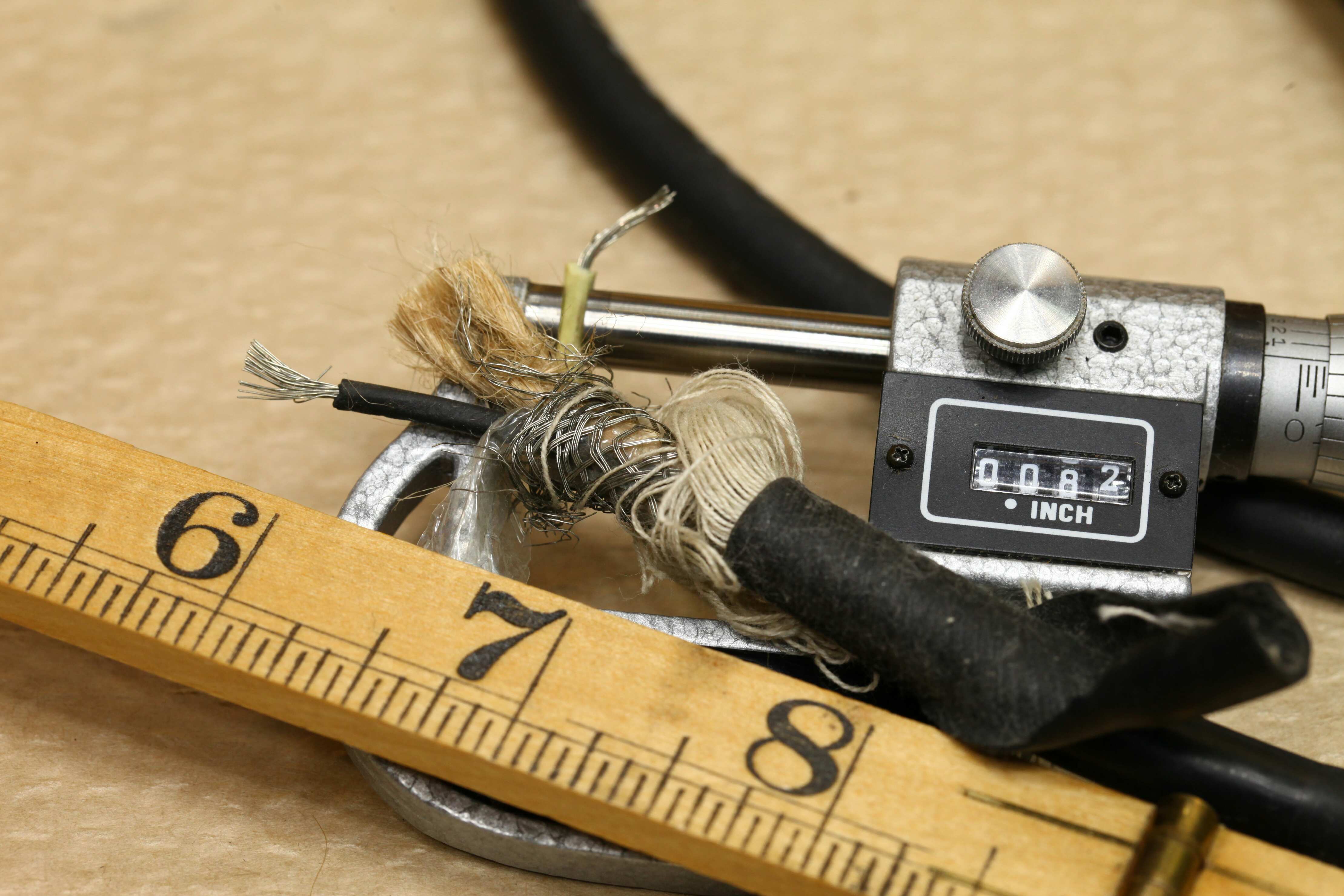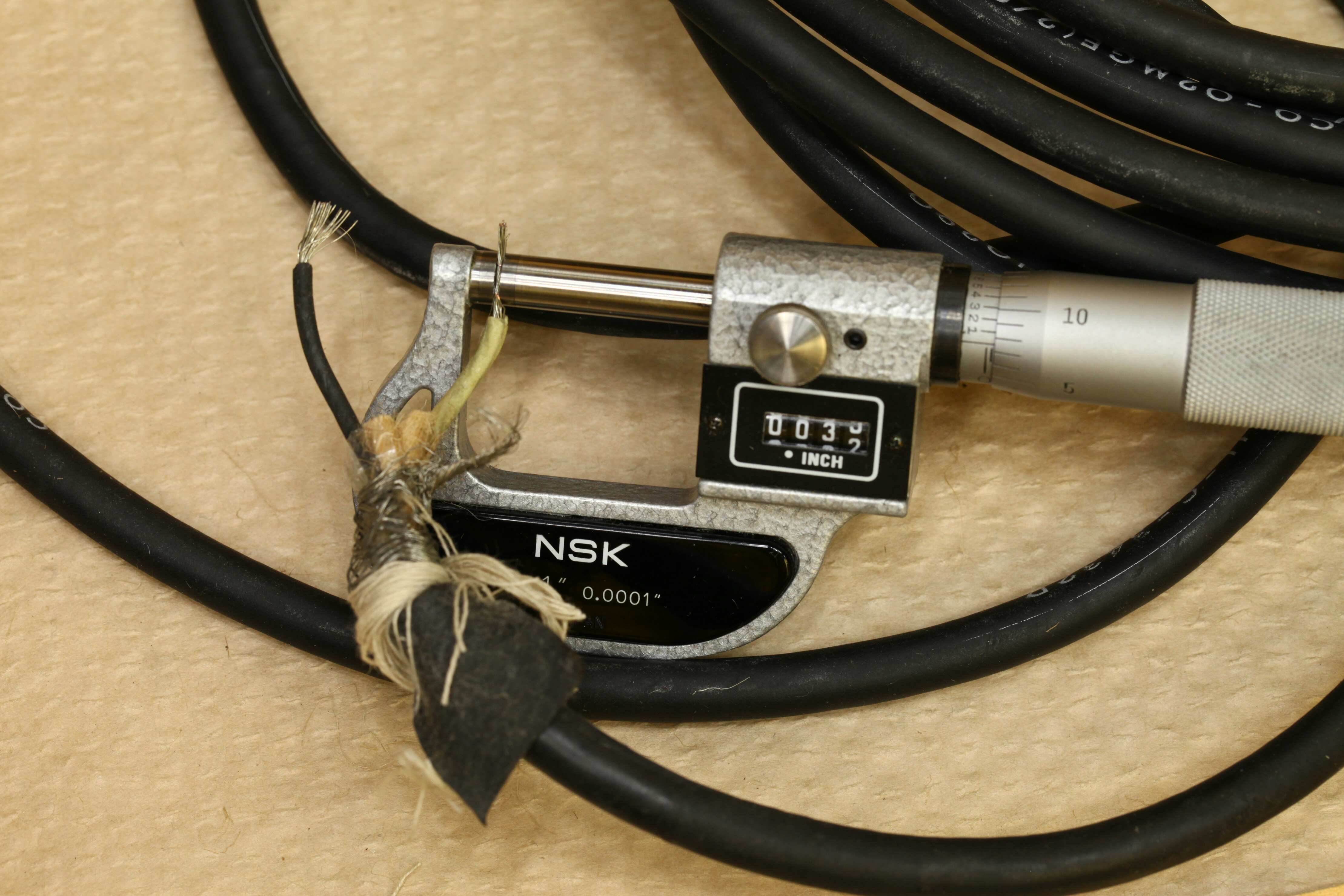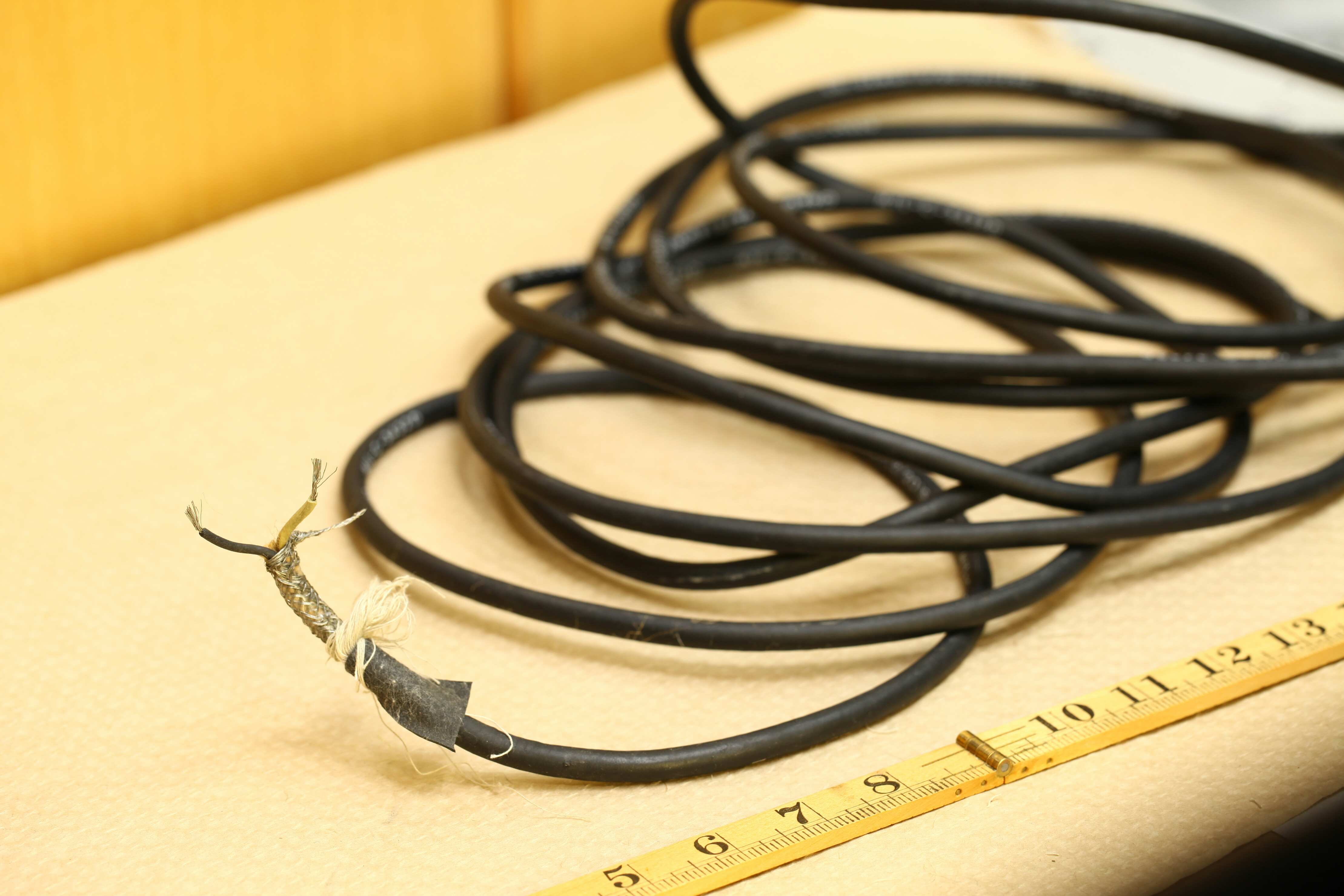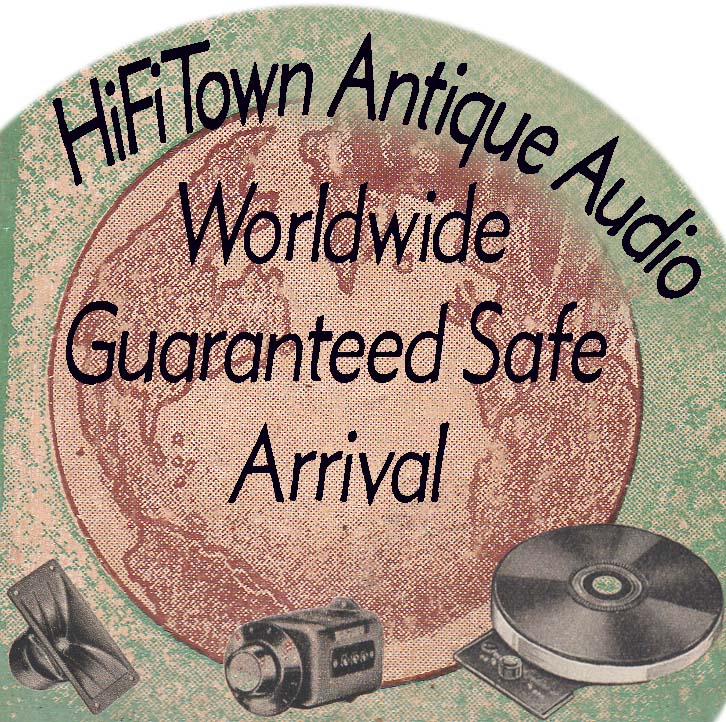There are so many modern and over-hyped ideas. Walt (founder of HiFiTown, and an avid listener with over 50 years of USA/Germany hifi / recording tube audio expertise) -- It was after many years of experimenting ; he studiously chose to avoid the wire swapping game. Instead learning to judge wire by quality, feel and overall sound performance. Time and time again, our search led us to rare, quite old US made wire that survived the ages -- and no longer produced. It was constrcuted to ultra high flexibility standards, and with simple, pure, natural materials no longer utilized by industry. This combined with electrical performance screening helped us acquire wire perfect for high end, high efficiency and vintage systems.
Stock Update: Febuary 2017 ... -- we are nearly out of stock of PhotoPhone and PhotoPhone T types!. This wire, was produced by the Cornish Rubber Wire Co, it's a little thinner, great for lower wattage tweeters, controls, switches and of course line stage, bridging, recording, microphones
This wire, also a high quality, tinned copper with low resistance and capacitance -- has many other applications it is better suited to beyond amplifier to speaker.... you can use this wire, thanks to the braided shield, for Phono / Moving Coil, interconnect (CD to preamp, to amp) and any other application where low signals, and resistance to electrostatic and electromagnetic interference are best avoided (to do this you must "ground" the shield, so that it is balanced).
All reports back have confirmed this Cornish rubber jcketed wire sounds terrific. Several repeat customers, in fact -- this is one of our very last sections!
It is slightly thinner type, about .05 on our micr. approximately between 14 and 15 AWG size after the jacket has beens stripped.
The tinning treatment is a traditional process in wire mfg. This process protects the underlying soft copper and allows easier soldering ...
This wire sounds outstanding, it's thick and alot more durable -- and just as detailed sounding. An entire 20ft (6m) section measures less than .5 OHM on our calibrated DCR meter!
This is among the very last, long sections multistrand copper / cotton & sisal inner jacket (see photos below) wire types we have in stock. The remaining lengths are some of the best looking of all .... from the 1950's Korean wartime era...this surviving wire has a thick, clean & supple outer rubber jacket. The metal mesh shielding gives it slightly more stiffness -- still it's plenty flexible.
We've heard amazing compliments from users of WE755A, Altec, JBL, Lansing and Shindo.
I just finished completely inspecting this unique 6m piece -- incredibly low reactance.
More listening reports from users/buyers just in.
A customer, Alex from Moscow - (Alex is a very experienced tube audiophile, and has heard many high-end vintage systems) -- he writes: "I have listened yours PhotoPhone speaker cables, it really nice, very clean, tender, every sound is stretches and a vocal is a main, a live. Thank you very much for good items."
It's a dream to physically handle and strip / solder as well....you won't believe how much nicer than newer era (like PolyVinyl/Teflon/Olefin etc) wires it is!!
A very pure rubber/sisal/cotton audio wire in mint condition from the 1950 & 60s. Perfect for Diy, Western Electric, RCA, Altec, Marantz, SE tube amps - infact, all tube powered sound systems. Simple really - it's the best rubbber; the best tinned soft copper, natural fiber & that's it -- no plastics! Carefully removed from surviving ERPI / Western Electric, RCA, Lansing and Motiograph sound systems. This type of wire carried amplifier output, to all speakers in various locations..such as cinema side-fill, recording and sound in pictures 1940s - early 1960s. Vintage cinema installs, sound trucks, nos storage, and in-service equipment. This wire is of very limited supply. The natural rubber is 50 years old, and made by few companies in the USA that was still using prewar style latex .... (Cornish Rubber Co.)--- it's all ORIGINAL - yet is still flexible, supple, easy to strip and totally corrosion free. PREWAR & early wire types of copper often have soft, beautiful stranded conductors.
Great for full range cabinets and entire systems, no matter the length. Useful for low or high power tube amps. The sound is neutral, detailed and non-colored - the quintessential vintage USA sound. This wire reads low resistance and capacitance on all meters. This outer black is quite thick at .31" OD. It has one white and one black conductor -- lined with non-reactive a natural sisal or cotton fiber runner. It is very soft and flexible/pliable even in our cold office. About like stiff cotton cord or thin rope! We have to throw away lots of other wire to find little of this grade, which takes years! Totally different from anything you see in modern use. Go into any modern HiFi shop -- you'll see them using ridiculous forms of wire speakers. It's the last & furthest length of wire you will be buying, and it's best to avoid gimmicks here. Buyers who need wire easily succumb ... we know! Just avoid the fancy sales pitch; the ribbon wire, magic boxes, "active" shielding, etc. Don't use excessively thick gauges either.
If you're a tube audiophile wondering what type of wire is best ... take note:
I am only making two points here here... this wire: the best, oldest, corrosion-free copper and great quality liner & rubber. That's it, not other silly mojo. Fancy new wire can have problems: poly-resins and plastics, teflon(s), foil shielding and ultra hard, quick cold draw, and highly purified metals result in predictably bright, brash sound. The the modern materials all have reactances within themselves and in response to each other... To many for even a scientist to predict. This old, soft copper has a nice feel and an old american neutral and detailed tone (not dark, nor too bright) and retains great detailed sound. It does not change your music like many other wires can. It's just cotton fiber and prewar rubber, around very old, very soft, rose colored, slow draw, stranded, tinned copper. Sometimes we really must take our thoughts back to the basics, remove all of the standard brainwashing we receive from Stereophile and other magazines, AudioAsylum and other forums (although they're rapidly coming around) they exist to pitch glamour and expense ... or the exact opposite ... that "wire is wire".
If neither are true..... then what is?
Good, pure (vintage) materials = nice, detailed, non colored sound.
It's time to judge more by feel and manufacturing technique. Less concern with raw specs, noise, resistance, OHFC etc. I'm sure you can tell from the wire's tint & gleam of the tinned surface, how it's very different from newer wire. No amount of flexing will fatigue it. Nice, no green oxides, even a long runs could only muster 1 ohms DCR at 20,000 cycles. That's very impressive. (Watch our video for a detailed explanation and test results.)
We personally use this wire for all of our speaker projects. Reliable and great sounding. Forget modern "oxygen free" claims. One of the worst problems with modern wire is it's chemical drenched vinyl jacket and aggressive dielectric insulators. Part of the story is rubber.
In the years preceeding WWII, rubber was a precious material. Entire countries were invaded for it. The success of the allies is partially credited to the enhanced production of petro formulated synthetic rubber. This allowed unlimited / rapid production of tires, insulation - all you need is more oil. In comparison, just a few years before say... the late 1930's, the rubber had to come from a far more natural process, and needed extraction from a tree! Cheaper, faster rubber may be good to win a war, but not for your speakers! By the war's end - 1950s on, almost all rubber was produced with DuPont's method. This post war production used lots of yucky "plastiziers" to make "fast" rubber, using less latex, more oil and hydrocarbons in an all plastic lining. Fine, but what happens is after many years - the plastizers spread around, it gets stiff and can crack. Post-war rubber is not as stable. That is not the worst of it; the copper tends to oxidize from the chemicals, changing to black or green. Later vinyl wire processes are worse! Find some 1970s clear vinyl stranded, chances are it will fee sticky to touch on the outside. These same chloride laced chemicals leeched to the inside and attached the outer strands of the wire. This results in high capacitance, high resistance and altered sound! Notice the photo below, how clean the inner cotton liner is! That's after nearly 50 years under the latex jacket.
No stickiness, goo, or smells. The materials are cured and stable -- they'll outlast us and perhaps our children. Any important hifi Altec, Jensen & WE system around here gets wired with this stuff for testing-- so we know the wire is nice sounding! It's predictably neutral performance will help your speakers & amps sound very clean indeed....limited supply --- buy soon or you may miss it.



Video's description:
We received wonderful comments back from happy customers he purchased our vintage PhotoPhone wire. It sold out quickly!
Back to the warehouse we found a limited supply of this 1940s through 1960s Cornish rubber Corporation wire, also known as PhotoPhone T. This wire was used in a mobile recording studio and sound outfit, that was operating from the 1940s through the 1960s.
In this video you'll see, hear and also observed me stripping a small end of the wire so that you can see how excellent and pliable it still is. Also you'll get a chance to observe the tinned Copper after slight scraping reveals the same rose-colored highly flexible stranded material of the prewar era.
Just as before you'll hear the neutral yet sweet mid range this wire allows when used low , medium and high power to audio systems...
Every single customer who purchased the PhotoPhone wire either sent us letters of praise. We quickly sold out. Thankfully, this Cornish Wire & Rubber Co. wire produces exactly the same level of detail with possibly a wider more LF region thanks the slightly thicker gauge. It was used for the same HiFi vintage sound recording purpose, and you'll hear the same great detail!
This wire contains a pair (2) of Black/White colored rubber inner 16 gauge conductors....highly durable wire that is ready to using your audio system of just about any power.
We've carefully screened it for reactance, and capacitance --- and found none. In fact an entire 50 foot-long section could only muster 1 ohm resistance when 20hz -- 20,000hz audio frequencies!
The demonstration audio in this video was played with under one watt of power from a push pull 6BQ5 tube amplifier and and all original Western Electric 755A. This is one of the many simple configurations that can generate true audio magic when used with this wire!




